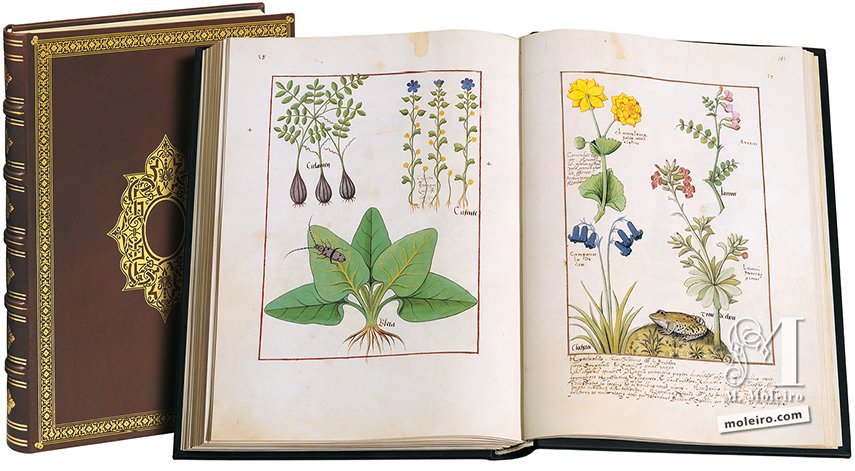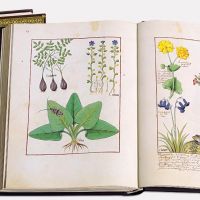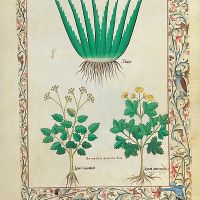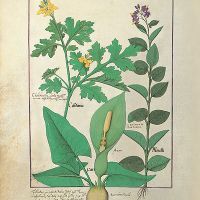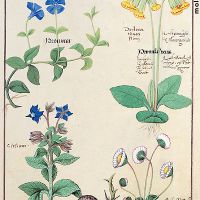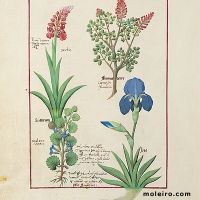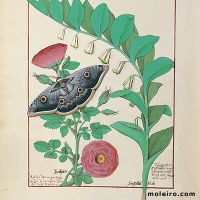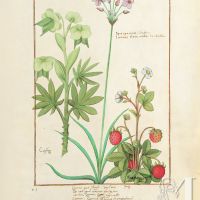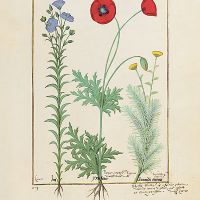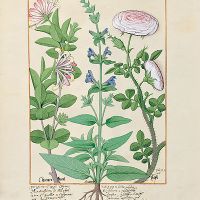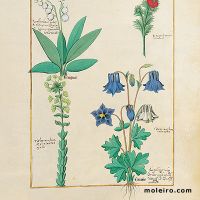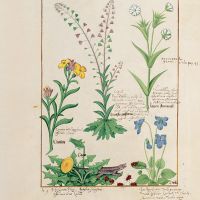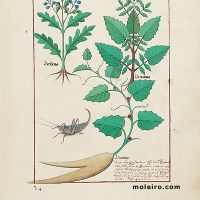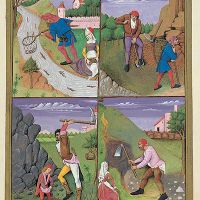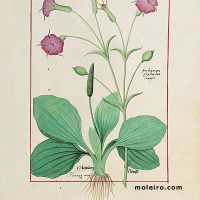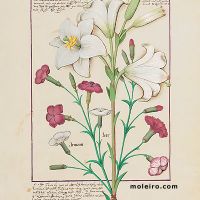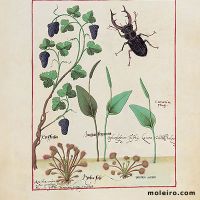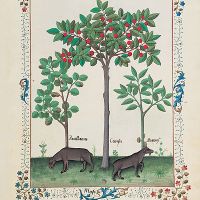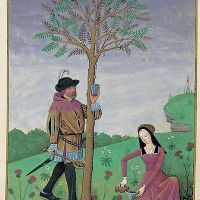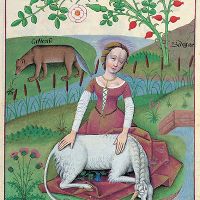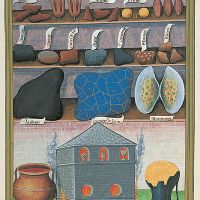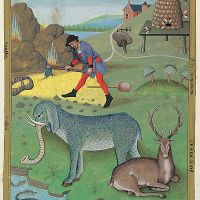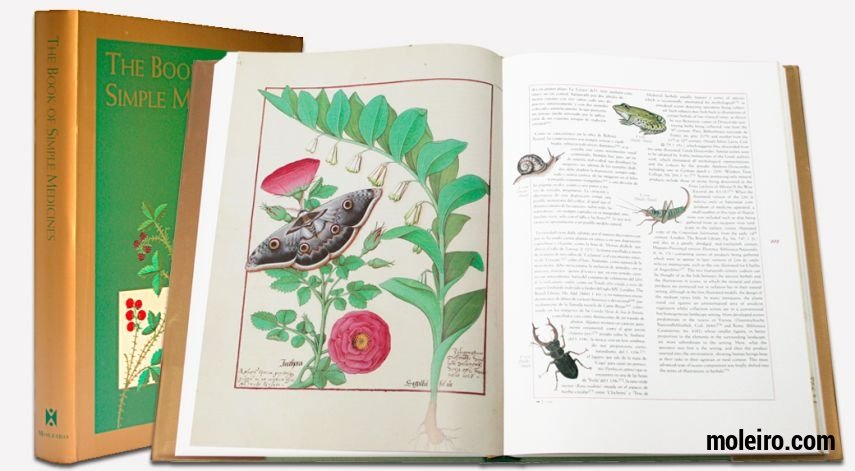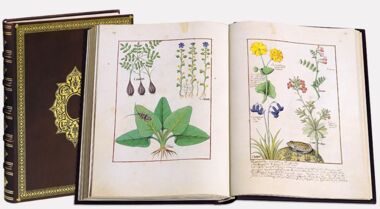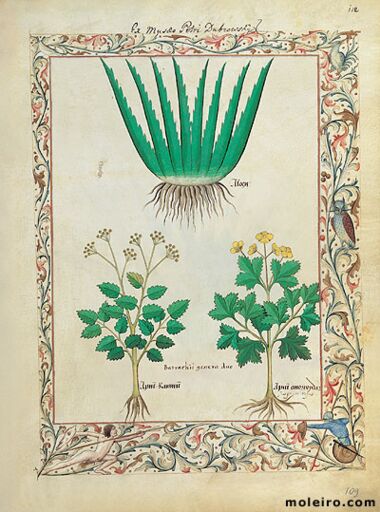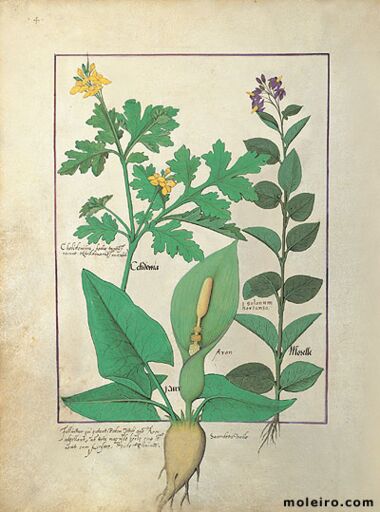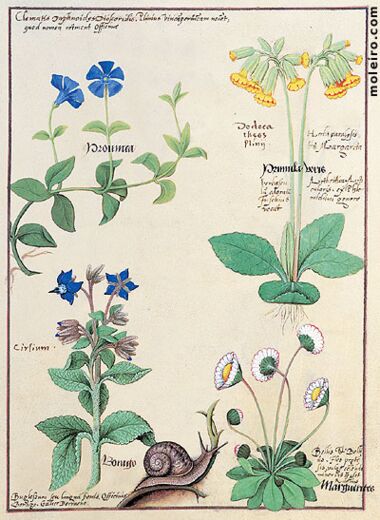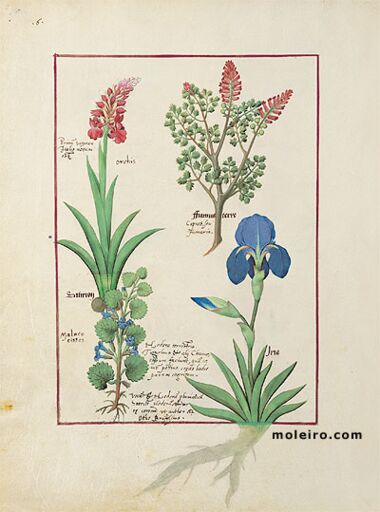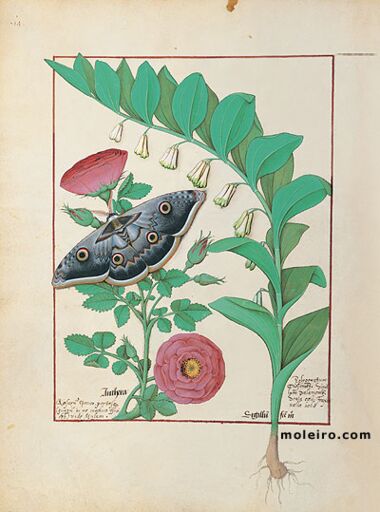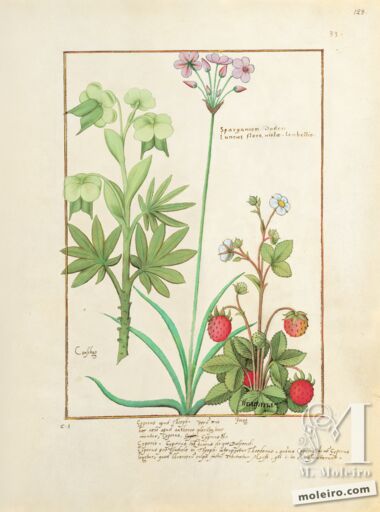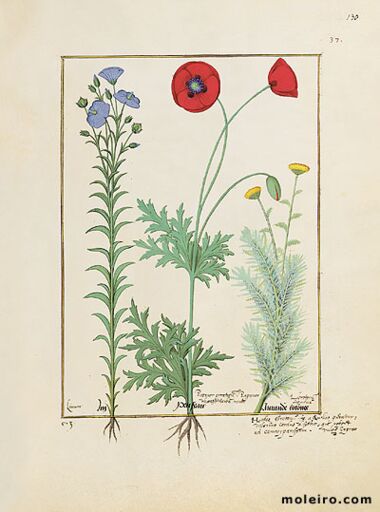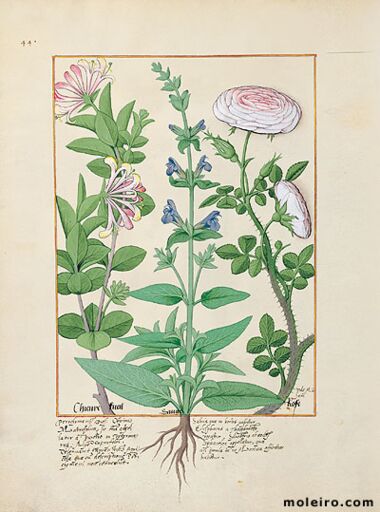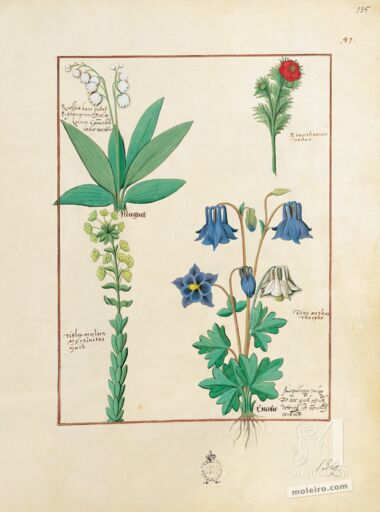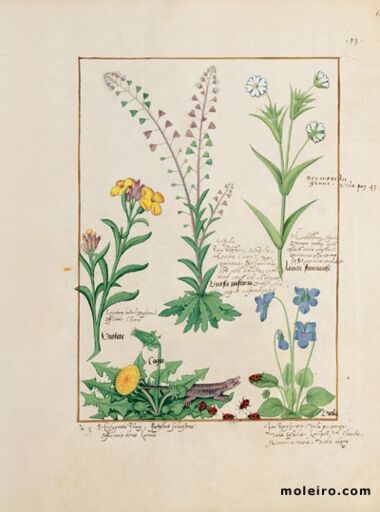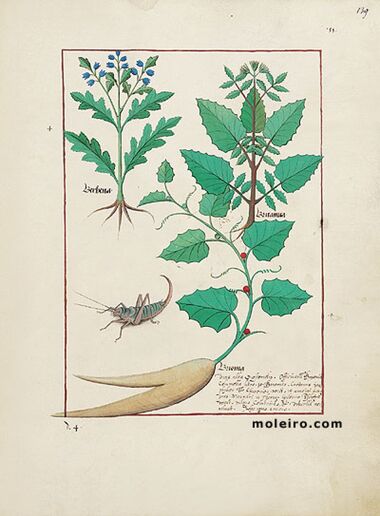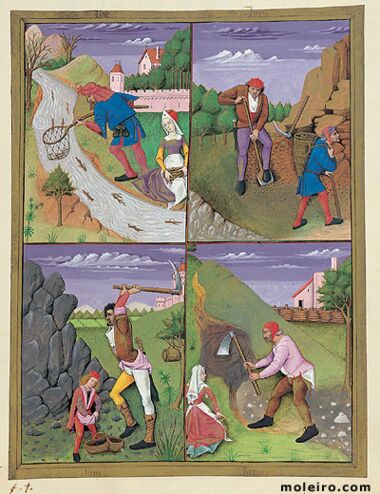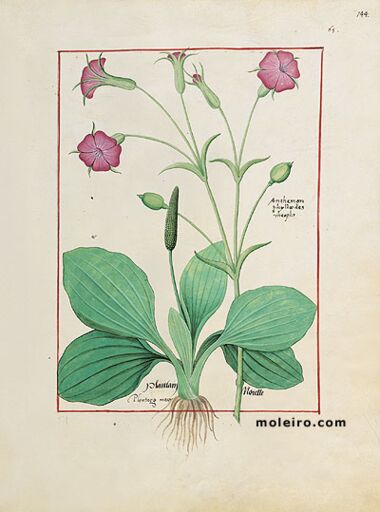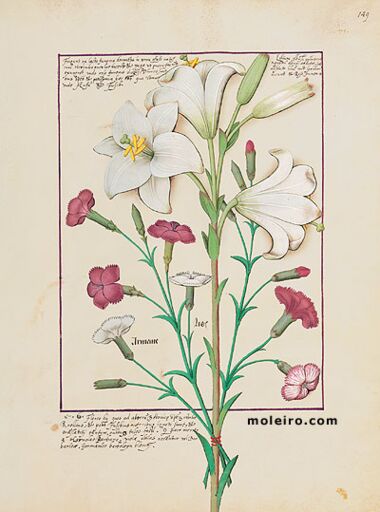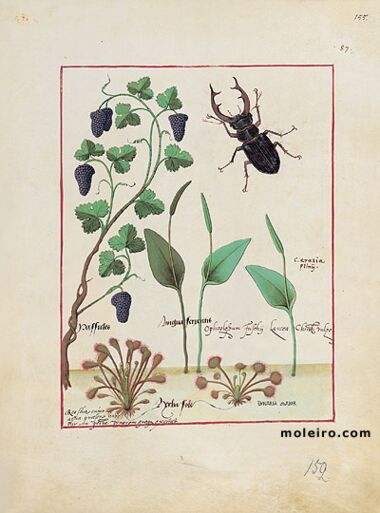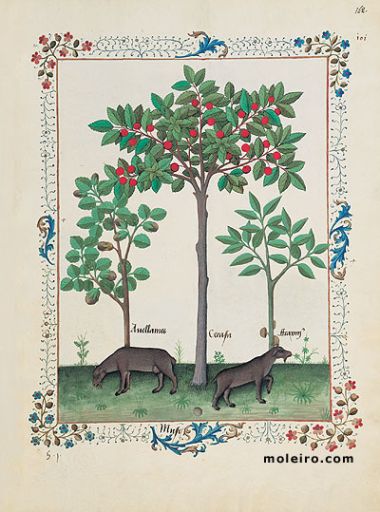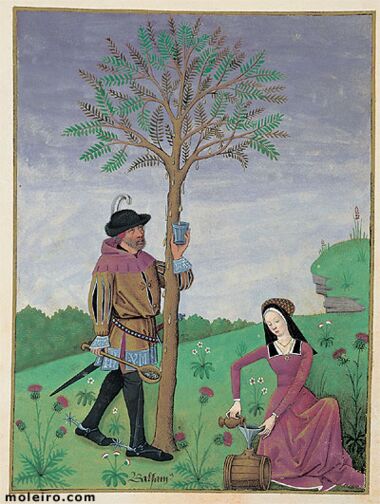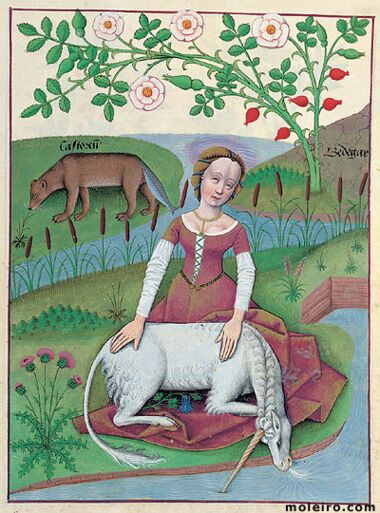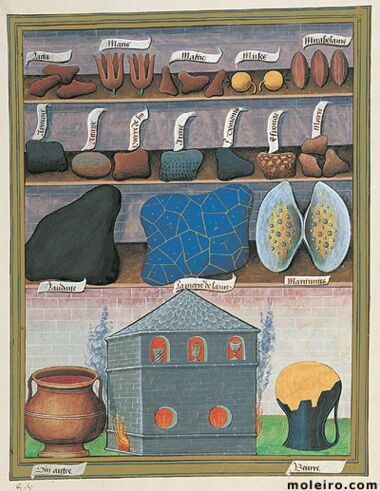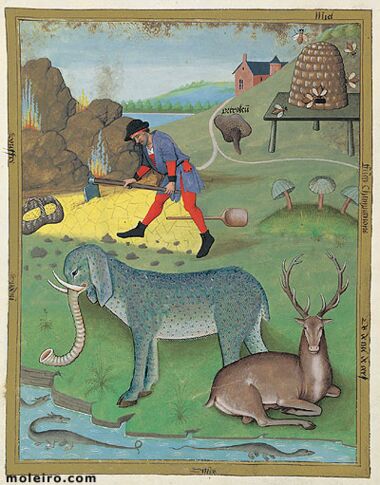Le Livre des simples médecines (The book of simple medicines) of the Russian National Library, St Petersburg, is a remarkable codex not only because of its outstandingly beautiful illustrations but also because it is the culmination of European medieval knowledge of the animal, vegetable and mineral substances used to cure or relieve disease.
This knowledge originated in classical antiquity. The books on medicine in Greek of that period were recuperated in Europe by means of indirect Latin translations from Arabic with the addition of remedies from the Islamic world. These translations were begun in the 11th century, initially in the city of Salerno. Working on such translations in the mid 12th century was Matthaeus Platearius, the physician to whom De medicinis simplicibus (“On simple medicines”), the most important and influential Salernitan compendium on this subject, was attributed.
The codex housed in St Petersburg was produced in France in the late 15th century for Count Charles of Angoulême and his wife Louise of Savoy. It consists of 220 pages divided into five parts: herbs and flowers, trees and their gums and resins, metals and minerals, animal products and other matters. It is followed by a splendid, 116-page atlas with 386 figures. The core of the text is the French translation of the compendium attributed to Matthaeus Platearius, with the addition of chapters from works of the following three centuries, a period when the knowledge of medicinal substances increased, based on the translations produced mainly in Toledo.
The atlas is similar in certain respects for its author – in all likelihood the great artist Robinet Testard – gathered together medieval illustrations of a diagrammatic nature or bearing no resemblance to reality with other realistic illustrations belonging to the Renaissance “back to nature” movement. Most of them depict medicinal plants and, to a lesser extent, curative animal or mineral products, although some scenes portray people gathering them. Examples of such scenes are found in the figure entitled “Aloe”, which does not refer to the aloes that bitter aloes are obtained from but to lignaloes, i.e. wood saturated in agalloch resin, often substituted in that period by aloe resin. The other three depict gold, alum and antimonite being collected (antimonite was used at that time as a desiccative medicine).
Another interesting feature of this codex is the annotations, like those to be seen on these two pages, by two physicians who handled the codex in the 16th century. They were both of a clearly Renaissance outlook and had editions in Greek and direct Latin translations of books on medicine from classical antiquity. They consequently deemed the original terms of the codex to be "barbaric" and added others in Greek and Latin, sometimes together with comments.
Dr. José María López Piñero
Professor emeritus of the History of Medicine Department,
University of Valencia
Aloe (Aloe):

Aloe purifies phlegm and melancholy, calms the nerves and stomach, purges cold humours, soothes stinging eyes and clarifies the sight. It combats headaches and obstructions of the liver and spleen. It provokes women’s menstrual flow and also remedies moral decay and corruption. It also restores a healthy colour to anyone losing it due to illness, and stanches and remedies a bleeding wound. Furthermore, it prevents hair loss. It eliminates worms from the stomach and other creatures that enter the ears. Finally it combats gout and inflamed ears.
Garlic (Allium):

Allium is garlic. Garlic is hot and dry to the fourth degree or, according to some, to the half of the fourth degree. There are two types of garlic: the first being common, domestic garlic and the other, wild garlic known as scordeon which is less hot and dry than domestic garlic. Other authors do not differentiate between the two. Wild garlic acts in a moderate fashion and is the one that must be used in formulae rather than domestic garlic which acts violently. We use wild garlic flowers which must be picked in late spring and hung in the shade to dry and can then be stored in a box for two years, although the finest garlic flowers are those picked fresh every year. We use the head of domestic garlic for it is able to assuage and expel poison, and ground garlic combats the bites of poisonous animals when applied to the wound. Garlic juice administered orally also expels poison, which is why it is known as peasants’ theriac. A remedy for stomach worms is to make a sauce of garlic, pepper, a little parsley and mint juice. The patient then eats bread dipped in this sauce. To open the channels of the liver and the urine ducts, a similar sauce must be made and diluted in wine and the juice of diuretic plants. To combat the obstruction of urine and pain in the entrails, cook garlic in oil and make it into paste a to be applied to the pubis and around the penis. To induce a woman’s menstruation, place a glove of garlic at the entrance of the womb, which will withdraw the retained menstrual flow. Constantine says that the same effect is produced by boiling garlic in water which the woman then bathes in, but only up to her navel. The garlic can also be boiled in oil. This oil is used to wet a wad which is then inserted into the vagina. In places where the skin has lost its colour and morpheas appear, pierce them in several spots from above with a lancet, rub the cut with roast garlic and then apply the garlic as a poultice. To remedy esthiomene herpes, roast several heads of garlic and their leaves together with a little pepper, then make a poultice of it. This preparation eliminates pus. Garlic damages the sight because it dries. But it also damages the entire body when used in excess for it causes leprosy, apoplexy and many ills. Wild garlic flowers are diuretics and must be administered with wine, syrup or another beverage. They also remedy all types of urine obstructions. Very few formulae in the Antidotary use domestic garlic, whereas many use wild garlic for its effects are far more moderate.
Celery (Apium):

Celery (Apium): Also known as apium and ache, it combats any obstruction of urine, of the liver and the spleen, and combats fatness of the spleen, jaundice, dropsy, abundant phlegm, frenzy, ordinary fever. Celery is harmful to women, children and epileptics who fall. There are three types of celery. One is the water dropwort or ache de rammes in French which is useful against kidney pain, urine obstruction, stomach spasms, and spleen pains. The other celery, Sardonia celery or ache de ris as it is known in French, is useful for those suffering from the spleen, and combats urine obstructions and kidney stones. It also releases retained menstrual flow and heals ulcers. Finally, the type known as lesser celandine, or ache de morroydes in French, dries haemorrhoids, helps lunatics and combats the black marks remaining after a wound is healed.
Borage (Borago):

Borage is a very commonplace plant with coarse leaves and it is also known as borrago. Hot and wet to the first degree. When green, the leaves have medicinal properties which are lost when dry. The seeds are also used in medicinal albeit less than the leaves. They have the power to produce good blood and are therefore used for those recovering from illness who are likely to have spasms or heart problems or who suffer from heartburn. It is very useful for those with heart disease or an excess of melancholic humour in the body to eat borage with meat or stews made of suet or fat. To remedy fainting or spasms one must make a syrup of borage juice with sugar. To combat heart disease one must also make a syrup of borage juice with sugar and add the powdered heart bone of a stag. To remedy melancholic passion, and likewise epilepsy, cook drumstick tree wood in borage juice and make a syrup from the liquid obtained. If this herb is not available, cook the seeds in water, strain the liquid and then make a syrup. The dry seeds can be stored perfectly well for two years. The root serves no medicinal purpose. Borage eaten raw also produces good blood. To remedy jaundice, cook with meat and eat frequently, and drink the juice of borage and endive, which some say is a type of lettuce.

Chick peas (Cicer): Cicer is the plant on which the seed we call chick pea grows. Hence when cicer is mentioned in a formula, one must understand this to mean the peas and not the other parts of the plant. Chick peas are highly nutritious, they loosen the belly, induce urine and purge women of retained menstrual flow. They always cause wind and therefore swelling. This is also why they increase the seed of reproduction and augment and cause lust. Chick peas are of two types: the green ones that have not yet ripened and the dry ones that have ripened. The two types of chick peas can be compared with dry and green beans. Since the properties and effects of green chick peas resemble those of green beans, and dry chick peas, those of dry beans, but not completely [...] White chick peas are hot to the first degree and wet in half this degree. They have the size and are as nutritious as beans but are not as good for they are difficult to digest and cause so much wind that they swell and distort the flesh of the entire body, producing an effect similar to that of wine cast upon very dry ground or that of yeast upon pasta. This is why those who eat these chick peas have such lovely, glistening skin for swollen flesh tenses the skin and makes it shining and clear. And they help increase reproduction for two reasons. One is that they provide a great deal of nourishment and thereby abundant reproduction matter, and the other is the wind and inflammation they cause. [...] When they are cooked or soaked in water they sweeten the water, leaving a sort of saliva in it too. It is this sweetness that gives chick peas modifying, laxative properties and enables them to expel and cause secretions. They are also highly nutritious and cause women’s milk to increase. Chick peas are also very useful for those suffering from jaundice and dropsy, and, furthermore, they remedy ulcers and make them disappear, particularly those on the genitals and behind or in front of the ears. In addition, because of their salty part, chick peas reduce and dispel thick humours, and induce urine and women’s menstrual flow. They also remove itchiness of the head and of the entire body if the affected area is washed in the cooking water. This same remedy cures both rampant and non-rampant herpes and also cleanses the skin. [...] In childbirth they also help the child emerge easily from its mother’s womb. They also expel worms from the belly. They are also useful against jaundice and obstructions of the liver and bile, and destroy stones in the kidneys and bladder, but they are dangerous for wounds and excoriations of the bladder and the kidneys.

Mandrake (Mandragoire): The mandrake is cold and dry although the authors do not specify to what degree. There are two forms of mandrake: male and female. The female mandrake has rough leaves and some say it is better medicine than the male but we use both alike. Some also say that the female mandrake has the shape of a man but this is not true for nature would never endow any plant with a human form. It is however true that some people shape it into manikins, as we have seen and also heard some country folk say. The part with the best medicinal use is the root bark, followed by the little fruit that emerge from it and, thirdly, the leaves. Once gathered, the root bark can be stored for four years and retain its goodness. It is able to cool, soothe and subdue, and also to induce sleep and drug, this being the same thing. In order to make a sick person sleep, the mandrake root must be stewed with a woman’s milk and egg white to make a syrup which is then applied to the forehead and temples. In order to remedy the headaches caused by heat, the leaves must be crushed and then applied to the temples. The head can also be spread with mandrake oil prepared as follows. Firstly, the mandrake fruits are crushed and steeped in oil for a long time. They are then put on the fire to cook a little, and finally the oil is filtered to obtain what is known as mandrake oil. This serves to induce sleep and also to relieve headaches caused by heat when applied to the forehead and temples. Applying this oil to the pulsating veins, which we call pulses, calms and reduces the heat caused by fever. Hot ulcers must be spread with this oil whilst still recent to draw out the pus. Mandrake fruit also serves this purpose, as do its leaves, either chopped or cut, or at least the powder of the leaves with the sap of a cold plant applied to the ulcer. To combat the stomach secretions caused by the acidity and bitterness of choleric humour, one must apply this oil to the belly and full length of the spine, and a little of it can also be administered in an enema. Some call this plant antimonium or androponitreos, and its seeds, albarolos.
Opium (Opium):

Opium (Opium): Opium is cold and dry to the fourth degree. There are two types of medicines called opium. One is Teban opium or opium of Tebas because it is produced overseas in the land of Tebas and is a juice made from poppies, as we shall see later. The other is known as triniacon opium which, as mentioned below, has a foetid odour. But we now wish to talk about the opium made from poppies, the type known as Teban opium for the reason given above which is made as follows. Cuts or incisions are made around the head of the poppy and the leaves. The milk that emerges is deposited around the poppy head and then gathered. This is what is called opium. This opium obtained from the lands around Tebas is the best although it is also produced near a city in Apulia called Trani. This opium is known as Tranian opium and is not as good. The best opium is Teban opium, which has a foul taste, is neither very hard nor very soft and is reddish in colour. But Teban opium is harder than Tranian opium. It can be stored for nine years, for it rots in the tenth. It is added to medicines to dilute and reduce the strength of hot medicines. Medicines containing opium are known as opiates. It is able to constipate and subdue but does not have this effect when added to hot medicines for they prevent it. To make a sick person sleep, the opium must be dissolved in a woman’s milk to which mandrake powder is added, forming an ointment to be rubbed on the temples. To combat hot ulcers such as, for example, the ulcers known as erysipelas caused by a choleric humour, or esthiomene herpes, an ulcer that corrupts and eats away everything around it, the opium must be prepared with the juice of a plant called bindweed or the juice of the white henbane to make a poultice. When a carob grain quantity of opium is taken orally, it subdues and puts all a man’s senses to sleep, making all pain disappear and inducing sleep. To combat very intense pain difficult to relieve, stew the opium with a woman’s milk and attar of roses to make a syrup. This may calm the pain for it subdues the place where it is applied thereby removing any pain. It may however cause subsequent harm for opium keeps pus in place and prevents it from evaporating or disappearing.
